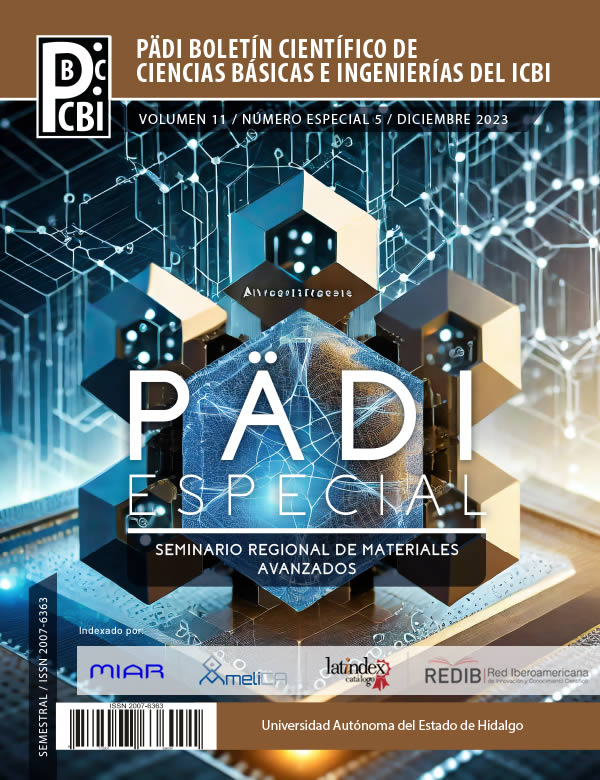Geometric quantification of chirality of carbon nanotubes
Abstract
Chirality is a very important property in nanomaterials due to its possible implications in processes such as asymmetric catalysis
and chiroptical phenomena. Carbon nanotubes can be classified according to their chiral vector and some of their properties change
depending on the values of that vector. In this work we use the Hausdorff chirality measure (HCM) to geometrically quantify the
chirality of carbon nanotubes with different chiral vectors. The calculated HCM values can be used to make preliminary predictions
regarding the optical response of carbon nanotubes.
Downloads
References
Buda, A. B. and Mislow, K. (1992). A hausdorff chirality measure. JACS, 114(15):6006–6012.
Charlier, J.-C., Blase, X., and Roche, S. (2007). Electronic and transport properties of nanotubes. Rev. Mod. Phys., 79:677–732.
Fecher, G. H., Kubler, J., and Felser, C. (2022). Chirality in the solid state: Chiral crystal structures in chiral and achiral space groups. Materials, 15(17).
Geng, H. Z., Zhang, X. B., Mao, S. H., Kleinhammes, A., Shimoda, H., Wu, Y., and Zhou, O. (2004). Opening and closing of single-wall carbon nanotubes. Chemical Physics Letters, 399:109–113.
Guijarro, A. and Yus, M. (2009). The Origin of Chirality in the Molecules of Life. A Revision from Awareness to the Current Theories and Perspectives of this Unsolved Problem. The Royal Society of Chemistry.
Kitaev, V. (2008). Chiral nanoscale building blocks – from understanding to applications. J. Mat. Chem., 18:4745–4749.
Kroto, H., Heath, J., and O’Brien, S. (1985). C60: Buckminsterfullerene. Nature, 318:162–163.
Li, Y., Higaki, T., Du, X., and Jin, R. (2020). Chirality and surface bonding correlation in atomically precise metal nanoclusters. Advanced Materials, 32(41):1905488.
Pelayo, J. J., Whetten, R. L., Perez, L., and Garzón, I. L. (2015). Geometric quantification of chirality in ligand-protected metal clusters. J. Phys. Chem. C, 119(51):28666–28678.
Robinson, M. and Marks, N. (2014). Nanocap: A framework for generating capped carbon nanotubes and fullerenes. Com. Phys. Comm., 185:2519–2526.
Robinson, M., Suarez-Martinez, I., and Marks, N. A. (2013). Generalized method for constructing the atomic coordinates of nanotube caps. Physical Review B, 87:155430.
Thamaraikannan, S., Sunny, M. R., and Pradhan, S. C. (2019). Chirality dependent mechanical properties of carbon nano-structures. Materials Research Express, 6(9):095018.
Vidu, R., Rahman, M., Mahmoudi, M., Enachescu, M., Poteca, T. D., and Opris, I. (2014). Nanostructures: a platform for brain repair and augmentation. Frontiers in systems neuroscience, 8(91):1–24.
Wagniere, G. (2007). ` On Chirality and the Universal Asymmetry. Verlag Helvetica Chimica Acta.
Yang, F., Wang, M., Zhang, D., Yang, J., Zheng, M., and Li, Y. (2020). Chirality pure carbon nanotubes: Growth, sorting, and characterization. Chemical Reviews, 120(5):2693–2758. PMID: 32039585.
Zeng, C. and Jin, R. (2017). Chiral gold nanoclusters: Atomic level origins of chirality. Chemistry - An Asian Journal, 12(15):1839–1850.
Zhu, Y., Guo, J., Qiu, X., Zhao, S., and Tang, Z. (2021). Optical activity of chiral metal nanoclusters. Accounts of Materials Research, 2(1):21–35.
Copyright (c) 2023 José de Jesús Pelayo Cárdenas, Ariadna Sánchez Castillo

This work is licensed under a Creative Commons Attribution-NonCommercial-NoDerivatives 4.0 International License.














